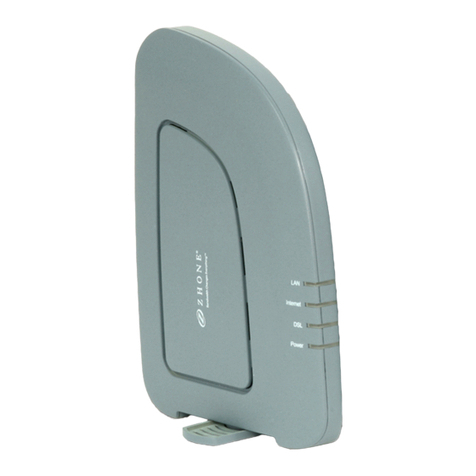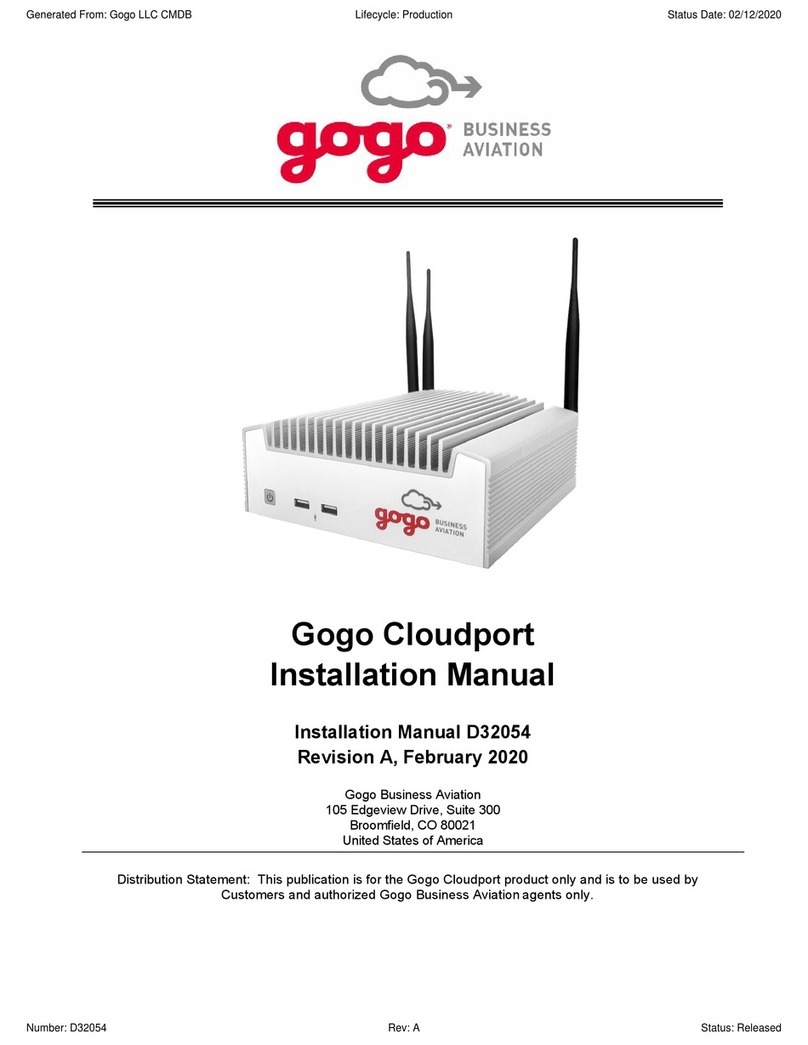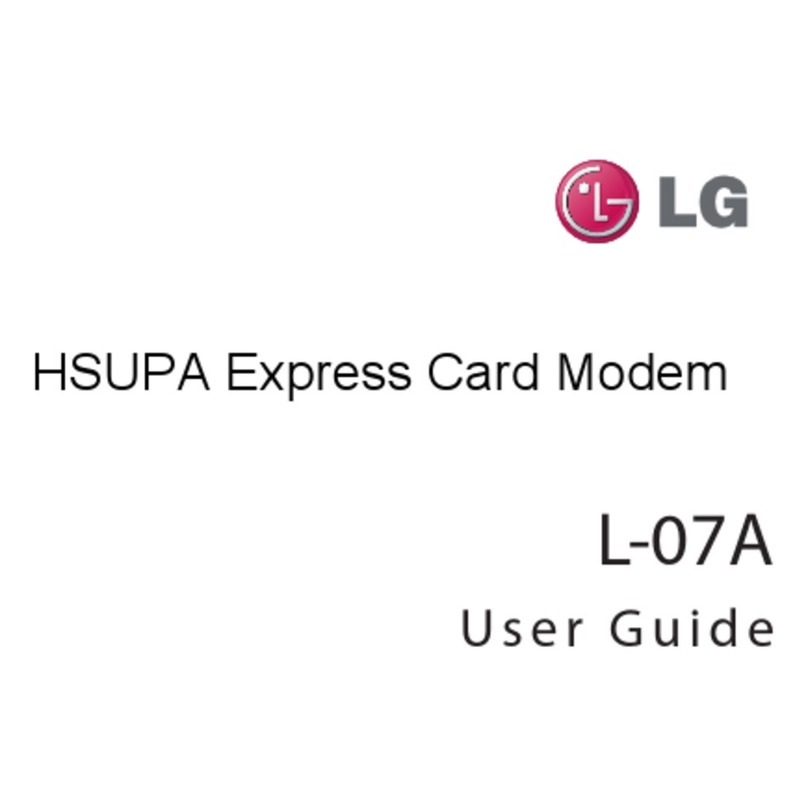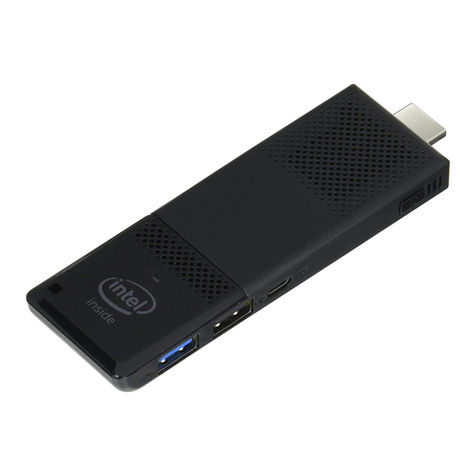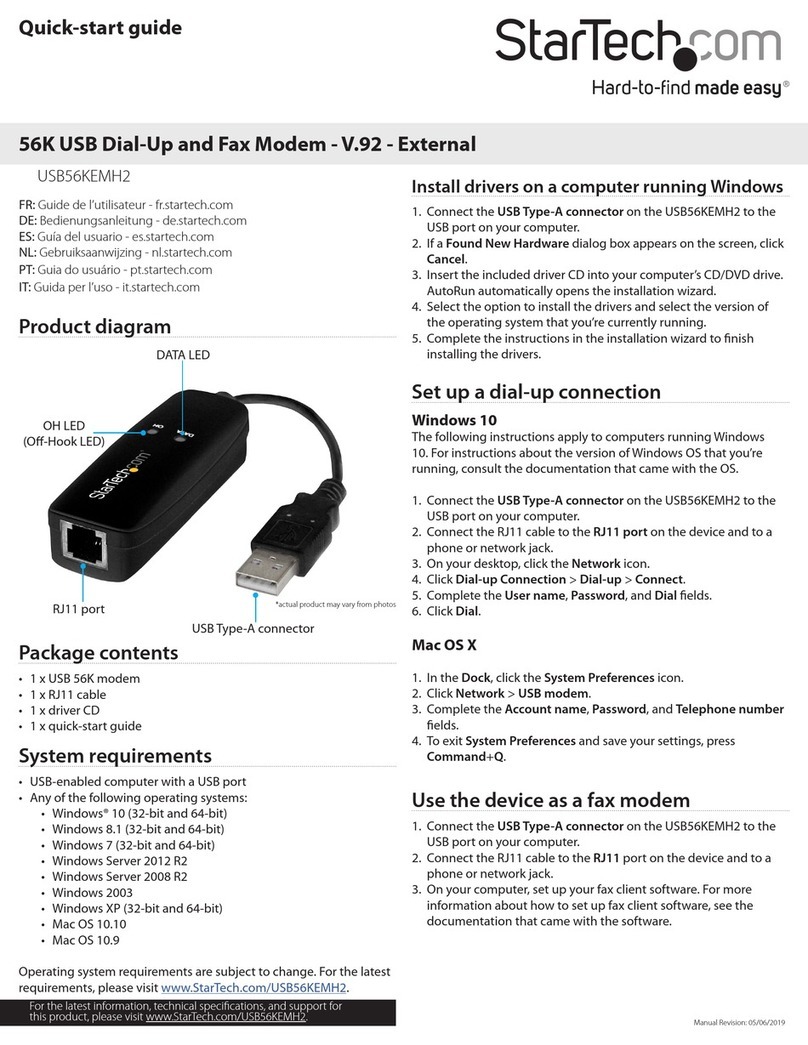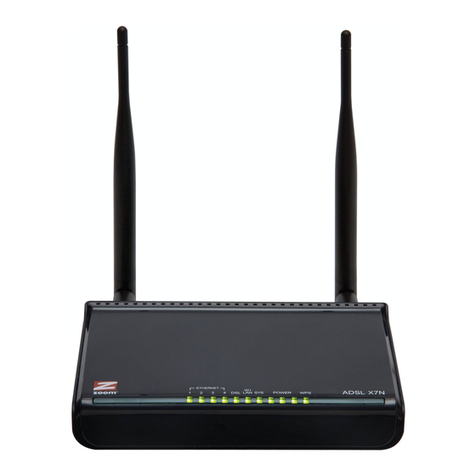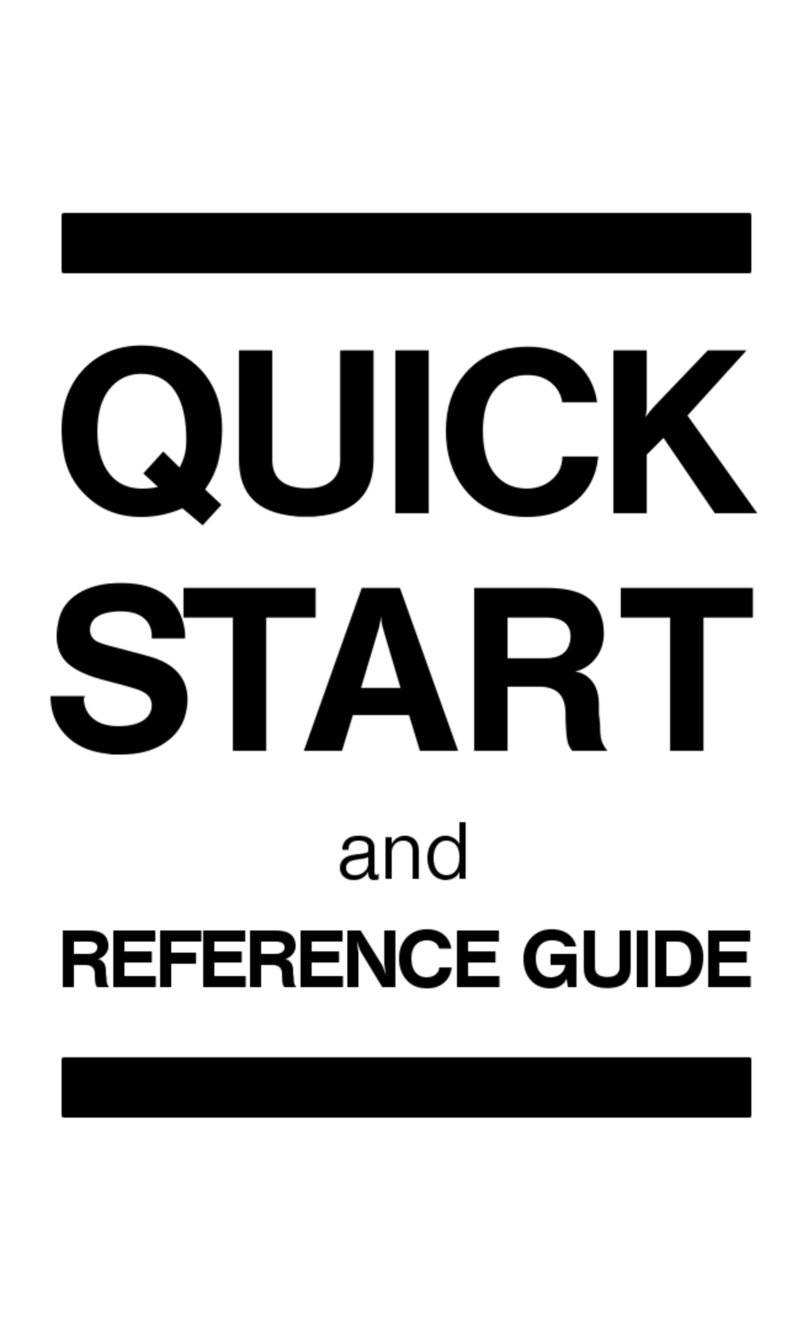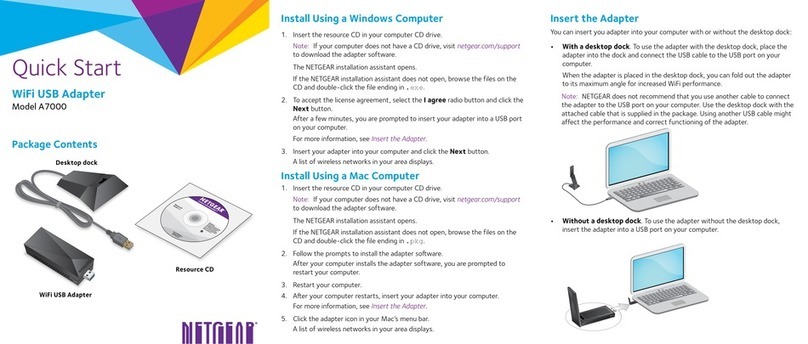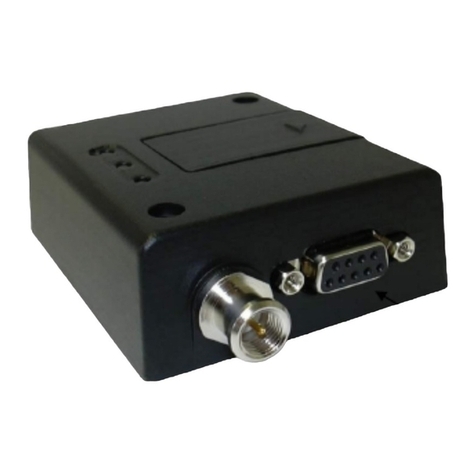Star Comm V.34 User manual

V.34 and V.32bis Data/Fax Modems
QUALITY COMMUNICATIONS PRODUCTS
Made in the U.S.A.
11-1006-002

1
TABLE OF CONTENTS
SUBJECT PAGE
INTRODUCTION 2
FRONT PANEL LIGHTS 2
BACK PANEL CONNECTORS 2
AT COMMAND SET 3
AT Commands 4
AT& Commands 8
AT% Commands 11
AT\Commands 12
AT+ Commands 14
MNP 10 Commands 15
AT COMMAND RESULT CODES 17
S REGISTERS 17
S REGISTER SUMMARY 18
S REGISTER DEFINITIONS 19
DUMB MODE OF OPERATION 30
LEASED LINE OPERATION 30
REMOTE CONFIGURATION 31
PASSWORD AND CALLER ID SECURITY 32
LOW POWER OPERATION 34
CERTIFICATIONS 35

2
INTRODUCTION
This manual covers configuration and operation of all V.34 and V.32bis external and rack mount models.
Sincemanyfeaturesdiscussedinthismanualareoptional,itisimportanttoverifythespecific configuration
of your device before proceeding with installation and configuration. It is suggested that you use theAT&V
command to verify the capabilities of your device. If the commands associated with an optional feature are
displayed on the last line of your active profile, that feature exists in your device.
FRONT PANEL LIGHTS
MR Modem Ready OH Off Hook
TR Terminal Ready CD Carrier Detect
SD Send Data AA Auto Answer
RD Receive Data HS High Speed
BACK PANEL CONNECTORS
LINE This RJ-11 connector should be used to connect the modem to a normal dial circuit or a
dedicated 2-wire leased circuit. For those models with the optional 4-wire leased circuit
interface, please refer to the following diagram:
Transmit Pins (TX) = Pins #3 & 4
Receive Pins (RX) = Pins #2 & 5
PHONE This RJ-11 connector is not present on all models. The phone jack directly parallels the line
connector and allows another device to be connected to the same line as the modem. This
connector is not installed on rack mount versions.
RS-232-CThis connector provides a standard RS-232-C(V.24) interface between the modem and a
wide range of DTE. The following signals are provided.
PIN # SIGNAL DESCRIPTION SOURCE NOTES
1Frame ground DTE/DCE
2Transmit Data DTE (SD light on front panel)
3Receive Data DCE (RD light on front panel)
4Request To Send DTE
5Clear To Send DCE
6Data Set Ready DCE (MR light on front panel)
7Signal Ground DTE/DCE
8Carrier Detect DCE (CD light on front panel)
12 Speed Indicator DCE
15 DCE Transmit Clock DCE
17 DCE Receive Clock DCE
20 Data Terminal Ready DTE (TR light on front panel)
22 Ring Indicator DCE
24 DTE Transmit Clock DTE (See &Xn command)

3
DUMB Next to the RS-232-C connector is a two pin header. When the pins of this connector are
MODE not connected (default), the modem operates in smart mode. When they are connected, the
modem operates in dumb mode. For more detail, please refer to the dumb mode section of
this manual.
POWER Thisconnectorispresentonallstandalonemodelsandacceptsa9VACor9–14VDCpower
source. On rack mount versions, a different power connector is used and it provides DC
voltagestothemodemfromtherackbackplane. CAUTION: Several DC poweroptions are
availableforspecialapplications. Modemsequippedwithspecialpoweroptionswillcontain
specifications that supersede the power specifications of this paragraph.
DB-25
RJ-11
POSITIVE Voltage
NEGATIVE Voltage
DB-25
RJ-11
POSITIVE Voltage
NEGATIVE Voltage
FRAME GROUND

4
AT COMMAND SET
Command Guidelines
ThebasicATcommandsusedtocontrolmodemoperationaredefinedinthissection. UnderAToperation,
themodemperformsautobaud,autoparityandautolengthfunctionsoneachheaderentered.Theautoparity
and autolength facilities can detect 7 or 8-bit characters of even, odd, or no parity with one stop bit.
Command Format
A command line is a string of characters sent from a DTE to the modem (DCE) while the modem is in a
command state. A command line has a prefix, a body, and a terminator. Each command line (with the
exception of the A/command) must begin with the character sequence AT and must be terminated by a
carriage return.
Characterswithinthecommandlineareparsedascommandswithassociatedparametervalues. Thebasic
commandsconsistofsingleASCIIcharacters,orsinglecharactersprecededbyaprefixcharacter(e.g.,"&"),
followed by a decimal parameter. Missing decimal parameters are evaluated as 0.
TheATsequencemaybefollowedbyanynumberofcommandsinsequence,exceptforcommandssuchas
Z, D, or A. Commands following commands Z, D, or A on the same command line will be ignored. The
maximumnumberofcharactersonany command line is39(including"A"and"T"). If a syntax errorisfound
anywhereinacommandlinecommand,theremainderofthelinewillbeignoredandtheERRORresultcode
will be returned.
Escape Code Sequence
When the modem has established a connection and has entered on-linedatamode,itispossible to break
into the data transmission in order to issue further commands to the modem in an on-linecommand mode.
This is achieved by sending to the modem a sequence of three ASCII characters specified by register S2.
The default character is '+'. The timing of the three characters must comply with specific time constraints.
There is a guard time before the first character (the pre-sequence time), a guard time following the third
character (the post-sequence time), and a guard time-out between the first and second characters and
between the second and third characters (the inter-charactertime). Thesetimesarecontrolledby the value
recorded in register S12.
Command Set Detail
The modem will respond to the commands detailed below. Parameters applicable to each command are
listedwiththecommanddescription. Thedefaultsshownforeachconfigurationcommandarethoseusedin
factory profile 0.
AT COMMANDS
A/ -Re-execute Command
The modem behaves as though the last command line had been re-sentbytheDTE. "A/"will repeat all the
commands in the command buffer.
AT=x -Write to Selected S-Register
This command writes the value x to the currently selected S-Register. An S-Register can be selected by
using the ATSn command.

5
AT? -Read Selected S-Register
This command reads and displays the selected S-Register.
A -Answer
The modem will go off-hook and attempt to answer an incoming call if correct conditions are met.
Bn -CCITT or Bell
When the modem is configured to allow either option, the modem will selectBell or CCITTmodulation for a
linespeedconnectionof300or1200bpsaccordingtotheparametersupplied. Anyotherlinespeedwilluse
a CCITT modulation standard.
B0 Selects CCITT operation at 300 or 1200 bps.
B1 Selects BELL operation at 300 or 1200 bps. (Default)
Cn -Carrier Control
Thiscommandisincludedforcompatibilityonly,andhasnoeffectotherthanreturningaresultcode. Theonly
valid parameter is 1.
Dn -Dial
Thiscommanddirectsthemodemtogoon-line,dialaccordingto thestringenteredandattempttoestablish
a connection. If no dial string is supplied, the modem will go on-lineandattempt the handshakein originate
mode. NOTE: If the ATD command is issued before the S1 register has cleared, the modem will respond
with the NO CARRIER result code.
DialModifiers. Thevaliddialstringparametersaredescribedbelow. Punctuationcharactersmay be used
for clarity, with parentheses, hyphen, and spaces being ignored.
0-9DTMF digits 0 to 9.
*The "Star" digit (tone dialing only).
#The "gate" digit (tone dialing only).
A-DDTMF digits A,B,C, and D.
JPerform MNP10 link negotiation at 1200 bps.
KEnable power level adjustment during MNP10 link negotiation.
LRe-dial last number.
PSelect pulse dialing.
TSelect tone dialing.
RIgnored.
S=n Dial the number stored in the directory.
!Flash: the modem will go on-hook for a time defined by the value of S29.
WWait for dial tone: the modem will wait for dial tone before dialing the digits following "W". If
dial tone is not detected within the time specified by S7, the modem will abort the rest of the
sequence.
@Wait for silence: the modem will wait for at least 5 seconds of silence in the call process
frequency band before continuing with the next dial string parameter. Ifthe modem doesnot
detectthese5secondsofsilencebeforetheexpirationofthecallaborttimer(S7),themodem
willterminatethecallattempt with aNOANSWERmessage. Ifbusydetectionisenabled,the
modem may terminate the call with the BUSY result code. If answer tone arrives during

6
execution of this parameter, the modem handshakes.
&Wait for credit card dialing tone before continuing with the dial string. If bong is not detected
within the time specified by S7, the modem will abort the rest of the sequence.
'Dialpause: themodemwillpauseforatimespecifiedbyS8beforedialingthedigitsfollowing
the ",'".
;Returntocommandstate: addedtotheendofadialstring,thiscausesthemodemtoreturnto
the command state after it processes the portion of the dial string preceding the ";".
^Toggles calling tone enable/disable: applicable to current dial attempt only.
() Ignored: may be used to format the dial string.
-Ignored: may be used to format the dial string.
<i> Invalid character: will be ignored.
En -Command Echo
The modem enables or disables the echo of characters to the DTE according to the parameter supplied.
E0 Disables command echo.
E1 Enables command echo. (Default)
Fn -Select Line Modulation (1442ONLY)
Thiscommandselectsthelinemodulationaccordingtotheparametersupplied. Thelinemodulationisfixed
unless Automode is selected.
F0 Selects auto-detect mode. All connect speeds supported by the modem are possible
according to the remote modem's preference.
F1 SelectsV.21orBell103accordingtotheBsettingastheonlyacceptablelinespeedresulting
in a subsequent connection.
F2 Not supported.
F3 SelectsV.23asthe only acceptablelinemodulationfor a subsequentconnection. Originator
is at 75 bps and answerer is at 1200bps.
F4 Selects V.22 1200 or Bell 212A according to the B command setting as the only acceptable
line speed for a subsequent connection.
F5 Selects V.22 bis as the only acceptable line modulation for a subsequent connection.
F6 Select V.32bis 4800 or V.32 4800 as the only acceptable line modulation for a subsequent
connection.
F7 Selects V.32 bis 7200 as the only acceptable line modulation for a subsequent connection.
F8 SelectsV.32bis9600orV.329600astheonlyacceptablelinemodulationsforasubsequent
connection.
F9 Selects V.32bis 12000 as the only acceptable line modulation for a subsequent connection.
F10 Selects V.32 bis 14400 as the only acceptable line modulation for a subsequent connection.
Hn -Disconnect (Hang-Up)
This command initiates a hang up sequence.
HO The modem will release the line if the modem is currently on-line, and will terminate any test
that is in progress.
H1 If on-hook, the modem will go off-hook and enter command mode.

7
In -Identification
The modem reports to the DTE the requested result according to the command parameter.
I0 Reports product code.
I1 Reports a pre-computed checksum.
I2 Reports "OK".
I3 Reports firmware revision (VX.XXX) model code.
I4 Reports OEM defined identifier string in Hayes compatible binary format.
I5 Reports Country Code parameter.
I6 Reports modem data pump model and internal code revision.
I7 ReportstheDAAcoderesultingfromMCUinterrogationoftheDAAforautoDAArecognition.
Ln -Speaker Volume
The modem sets the speaker volume control according to the parameter supplied.
L0 Low volume.
L1 Low volume. (Default)
L2 Medium volume.
L3 High volume.
Mn -Speaker Control
M0 Speaker is always off.
M1 Speaker is on during call establishment, but off when receiving carrier. (Default)
M2 Speaker is always on.
M3 Speaker is off when receiving carrier and during dialing, but on during answering.
Nn -Automode Enable
This command enables or disables Automode detection.
N0 Automode detection is disabled.
N1 Automode detection is enabled. (Default).
On -Return to On-Line Data Mode
This command determines how the modem will enter the on-line data mode.
O0 Enters on-line data mode, without a retrain.
O1 Enters on-line data mode with a retrain.
P -Set Pulse Dial Default
This command forces pulse dialing until the next T dial modifier or T command is received.
Qn -Quiet Results Codes Control
The command enables or disables the sending of result codes to the DTE according to the parameter
supplied.
Q0 Enables result codes to the DTE. (Default)
Q1 Disables result codes to the DTE.

8
Sn -Read/Write S-Register
The modem selects an S-Register,performs anS-Registerreadorwritefunction,orreportsthevalueofan
S-Register.
nEstablishes S-Register n as the last register accessed.
n=v Sets S-Register n to the value v.
n? Reports the value of S-Register n.
T -Set Tone Dial Default
This command forces DTMF dialing until the next P dial modifier or P command is received.
Vn -Result Code Form
This command selects the sending of short-form or long-form result codes to the DTE.
V0 Enables short-form (terse) result codes.
V1 Enables long-form (verbose) result codes. (Default)
Wn -Connect Message Control
This command controls the format of CONNECT messages.
W0 Modem reports DTE speed. (Default)
W1 Modem reports line speed error correction protocol and DTE speed.
W2 Modem reports the DCE speed.
Xn -Extended Result Codes
Thiscommandselectswhich subset oftheresultmessageswillbeusedbythemodemto informtheDTEof
the results of commands.
X0 Disablesmonitoringofbusytones,sendsonlyOK,CONNECT,RING,NOCARRIER,ERROR,
and NO ANSWER result codes. Blind dialing is enabled.
X1 Disablesmonitoringofbusytones,sendsonlyOK,CONNECT,RING,NOCARRIER,ERROR,
NO ANSWER, and CONNECT XXXX(XXXX=rate). Blind dialing is enabled.
X2 Disablesmonitoringofbusytones,sendsonlyOK,CONNECT,RING,NOCARRIER,ERROR,
NO DIAL TONE, NO ANSWER, and CONNECT XXXX.
X3 Enables monitoringofbusy tones; sendonlyOK, CONNECT, RING,NOCARRIER, ERROR,
NO ANSWER, and CONNECT XXXX. Blind dialing is enabled.
X4 Enables monitoring of busy tones, sends all messages. (Default).
Yn -Long Space Disconnect
This command enables/disables the generation and response to long space disconnect.
Y0 Disables long space disconnect. (Default)
Y1 Enables long space disconnect.
Zn -Soft Reset and Restore Profile
Themodemperformsasoftresetandrestores(recalls)theconfigurationprofileaccordingtotheparameter
supplied. If no parameter is specified, zero is assumed.

9
Z0 Soft reset and restore stored in profile 0.
Z1 Soft reset and restore stored profile 1.
AT& COMMANDS
&Cn -RLSD (DCD) Option
This command controls the RLSD output inaccordance with the parameter supplied.
&CO RLSD remains ON at all times.
&C1 RLSD follows the state of the carrier. (Default)
&Dn -DTR Option
This command interprets the ON to OFF transition of the DTR signal from the DTE in accordance with the
parameter supplied.
&DO DTR is ignored and assumed on.
&D1 DTR drop forces modem to command state without disconnecting.
&D2 DTR drop forces hang up, auto-dial is inhibited. (Default)
&D3 DTR drop forces modem to soft reset.
&Fn -Restore Factory Configuration (profile)
This command loads the factory default configuration (profile).
&F0 Restore factory configuration 0.
&F1 Restore factory configuration 1.
&Gn -Select Guard Tone
This command controls the generation of guard tone.
&G0 Disables guard tone.
&G1 Disables guard tone.
&G2 Selects 1800 Hz guard tone.
&Jn -Telephone Jack Control
This command is only included for compatibility and performs no function except to load the S-Register.
&J0 &J0 command. (Default)
&J1 &J1 command.
&Kn -Flow Control
This command defines the DTE/DCE (terminal/modem) flow control mechanism.
&K0 Disables flow control.
&K3 Enables RTS/CTS flow control. (Default)
&K4 Enables XON/XOFF flow control.
&K5 Enables transparent XON/XOFF flow control.
&K6 Enables both RTS/CTS and XON/XOFF flow control.

10
&Ln -Leased Line Operation
This command selects dial up or leased line operation.
&L0 Selects dial up operation.
&L1 Selects leased line operation.
&Mn -Asynchronous/Synchronous Mode Selection
This command determines the DTR operating mode. The modem treats the &M command as a subset of
the &Q command.
&M0 Selects direct asynchronous operation.
&M1 Selects synchronous connect mode with asynch off-line command mode.
&M2 Selects synchronous connect mode with asynch off-line command mode. Same as &M1
exceptthat&M2enablesDTRdialingofdirectoryslot0. ThemodemwilldisconnectifDTRis
OFF for more than the period in S25.
&M3 Selects synchronous connect mode. This mode allows DTR to act as a talk/data switch. The
call is manually initiated while DTR is inactive. When DTR becomes active, the handshake
proceeds in originate or answer mode according to S14 bit 7.
&Pn -Select Pulse Dial Make/Break Ratio
This command determines the make/break ratio used during pulse dialing.
&P0 Selects 39%-61% make/break ratio at 10 pulses per second. (Default)
&P1 Selects 33%-67% make/break ratio at 10 pulses per second.
&P2 Selects 39%-61% make/break ratio at 20 pulses per second.
&P3 Selects 33%-67% make/break ratio at 20 pulses per second.
&QN -Sync/Async Mode
This command is an extension of the &M command is used to control the connection modes permitted. It is
used in conjunction with S36 and S48.
&Q0 Selects direct asynchronous operation.
&Q1 Selects synchronous connect mode with asynch off-line command mode.
&Q2 Selects synchronous connect mode with asynch off-line command mode and enables DTR
dialing of directory 0.
&Q3 Selectssynchronousconnectmodewithasynchoff-linecommand mode andenables DTR to
act as Talk/Data switch.
&Q4 Selects AutoSync operation. Auto-synch operation when used in conjunction with the Hayes
Synchronous Interface (HSI) capability in the DTE, provides synchronous communication
capability from an asynchronous terminal.
&Q5 The modem will try to negotiate an error-corrected link. (Default)
&Q6 Selects asynchronous operation in normal mode (speed buffering).
&Rn -RTS/CTS Option
This selects how the modem controls CTS. CTS operation is modified if the hardware flow control is
selected.
&R0 Insyncmode,CTStracksthestate of RTS; the RTStoCTSdelayisdefinedby S26. In async

11
mode, CTS acts according to V.25bis handshake.
&R1 Insyncmode,CTSisalwaysON. Inasyncmode,CTSwillonlydropifrequiredbyflowcontrol.
(Default)
&Sn -DSR Override
This command selects how the modem will control DSR.
&S0 DSR will remain ON at all times.
&S1 DSRwillbecomeactiveafteranswertonehasbeendetectedandinactiveafterthecarrierhas
been lost. (Default)
&Tn -Test and Diagnostics
Themodemwillperformselected test anddiagnosticfunctionsaccordingtotheparametersupplied. Atest
can be run only when in asynchronous operation in non-error-correction mode (normal or direct mode). To
terminate a test in progress, the escape sequence must be entered first, except for parameters 7 and 8. If
S18 is non-zero, a test will terminate automatically after the time specified by S18 and display the OK
message.
&T0 Terminates test in progress.
&T1 Initiates local analog loopback, V.54, Loop 3.
&T2 Returns ERROR.
&T3 Initiates local digital loopback, V.54 Loop 2.
&T4 Enables digital loopback for remote request. (Default)
&T5 Disables digital loopback for remote request.
&T6 Requests a remote digital loopback, V.54 Loop 2 without self test.
&T7 Requests remote digital loopback, V.54 Loop 2, with self test.
&T8 Initiates local analog loopback, V.54 Loop 3, with self test.
&V -Display Current Configuration and Stored Profiles
Reports the current (active) configuration, the stored (user) profiles, and the first four stored telephone
numbers.
&V1 -Display Status of Last Call
Presents an analysis of modem performance and telephone circuit quality during the last call.
&Wn -Store Current Configuration
SavesthecurrentconfigurationandS-Registersinoneofthetwouserprofileswhicharekeptinnon-volatile
memory (NVRAM).
&W0 Store as profile 0.
&W1 Store as profile 1.
&Xn -Select Synchronous Clock Source
Selects the source of the transmit clock for synchronous operation.
&X0 Internal clock from DCE.
&X1 External clock from DTE. (DTE must supply clock on pin 24)

12
&X2 Internal clock from DCE synchronized with carrier from remote modem.
&Yn -Designate a Default Profile
Selects the user profile that will be used after a reset.
&Y0 Profile 0.
&Y1 Profile 1.
&Zn -Store Telephone Number
The modem can store up to four telephone numbers.
&Zn=x Where n = 0 to 3 and x = dial string.
AT% COMMANDS
%C -Enable/Disable Data Compression
Enables or disables data compressionnegotiation. Themodem canonlyperformdatacompressiononan
error corrected link.
%C0 Disables data compression.
%C1 Enables MNP5 data compression negotiation.
%C2 Enables V.42 bis data compression.
%C3 Enables both V.42 bis and MNP5 data compression. (Default)
%En -Enable/Disable Line Quality Monitor and Auto-Retrain or Fallback/Fall Forward
Controls whether or not the modem will automatically monitor the line quality and request a retrain (%E1) or
fall back when line quality is insufficient or fall forward when line quality is sufficient (%E2).
%E0 Disable line quality monitor and auto-retrain.
%E1 Enable line quality monitor and auto-retrain.
%E2 Enable line quality monitor and fallback/fall forward. (Default)
%L -Line Signal Level
Returns a value which indicates the received signal level.
%Q -Line Signal Quality
Reports line signal quality.
AT\COMMANDS
\An -Select Maximum MNP Block Size
The modem will operate an MNP error corrected link using a maximum block size controlled by the
parameter supplied.
\A0 64 characters.
\A1 128 characters. (Default)

13
\A2 192 characters.
\A3 256 characters.
\Bn -Transmit Break to Remote
In non-error-correction mode, the modem will transmit a break signal to the remote modem with a lengthin
multiples of 100 ms according to parameter specified. If a number in excess of 9 is entered, 9 is used.
\Fn -Set Answer or Originate Mode
In dial operation the answering modem typically assumes answer responsibility and the calling modem
assumes originate responsibility. In leased line operation where there is no implied calling or answering
modem, the relationship must be established with this command. Please note that setting the modem to
answer mode is not the same as setting the modem to auto-answermode. Sregister0muststillbesetfor
auto-answer dial operation.
\F0 Sets modem to answer mode.
\F1 Sets modem to originate mode.
\Gn -Modem to Modem Flow Control (XON/XOFF) (1442 ONLY)
In non-error-correction mode, the modem enables or disables the generation or recognition of modem to
modemXON/XOFFflowcontrolaccordingtotheparametersupplied. Inerrorcorrectionmode,thesettingof
modemtomodemXON/XOFFflowcontrolisignored. However,theserialportflowcontrolsettings(AT&K)
remain active during a reliable link.
\G0 Disables modem to modem flow control. (Default)
\G1 Enables modem to modem XON/XOFF flow control.
\Hn -Auto-Connect
Inmanycaseswherethedumbmodeofoperationisrequired,itisnecessaryforthemodem tobeconfigured
so that it constantly attempts to go off hook and connect as configured. This is necessary for leased line
operation or for operation with an external manual dialer. This command allows that to occur.
\H0 Normal dial/answer operation under AT command control. (Default)
\H1 Modem constantly attempts to go off hook and connect as configured.
\Kn -Break Control
Controls the response of the modem to a break received from the DTE or the remote modem or the \B
commandaccordingtotheparametersupplied. Theresponseisdifferentinthreeseparatestates. Thefirst
state is where the modem receives a break from the DTE when the modem is operating in data transfer
mode:
\K0 Enter on line command mode, no break sent to the remote modem.
\K1 Clear data buffers and send break to remote modem.
\K2 Same as 0.
\K3 Send break to remote modem immediately.
\K4 Same as 0.
\K5 Send break to remote modem in sequence with data. (Default)
The second case is where the modem is in the on-line commandstate(waitingfor AT commands)during a
data connection and the\B is received in order to send a break to the remote modem:

14
\K0 Clear data buffers and send break to remote modem.
\K1 Same as 0.
\K2 Send break to remote modem immediately.
\K3 Same as 2.
\K4 Send break to remote modem in sequence with data.
\K5 Same as 4. (Default)
Thethirdcaseiswhereabreakis received from aremotemodemduringanon-errorcorrectedconnection:
\K0 Clears data buffers and send break to the DTE.
\K1 Same as 0.
\K2 Send a break immediately to DTE.
\K3 Same as 2.
\K4 Send a break in sequence with received data to DTE.
\K5 Same as 4. (Default)
\Nn -Operating Mode
This command controls the preferred error correcting mode to be negotiated in a subsequent data
connection.
\N0 Normal speed buffered mode (disables error correction).
\N1 Direct mode.
\N2 MNP only.
\N3 MNP with fallback to normal mode (auto reliable mode).
\N4 V.42 only.
\N5 V.42 with fallback to MNP only.
\N6 V.42 with fallback to MNP with fallback tonormal. (Default)
\V1 -Enhanced Connect Message
Presents a comprehensive, single line connect message, showing DTE speed, DCE speed, protocol and
compression.
AT+ COMMANDS
+MS -Select Modulation
This extended format command selects the modulation, optionally enables or disables automode, and
optionallyspecifiesthelowestandhighestconnectionratesusingonetofoursubparameters. Thecommand
format is:
+MS=<mod>[,[<automode>][,[<minrate>][,[<maxrate>]]]]<CR>
Notes:
1. For 14400 bps and lower speeds, the Nn command and S37 register can alternatively be used in
whichcasethe+MS subparameterswillbemodifiedtoreflecttheNnandS37=x settings. Useofthe
Nn and S37=x commands is not recommended but is provided for compatibility with existing
communication software. (S37 is not updated by the +MS command).

15
2. Subparameters not entered (enter a comma only or <CR> to skip the last subparameter) remain at
their current values.
Reporting Selected Options
The modem can send a string of information to the DTE consisting of selected options using the following
command:
+MS?
The response is:
+MS:<mod>,<automode>,<minrate>,<maxrate>
For example,
+MS: 11,1,300,33600 (shows default values)
Reporting Supported Options
The modem can send a stringofinformationto the DTEconsistingofsupported options usingthefollowing
command:
+MS=?
The response is:
+MS:(list of supported <mod> values),(list of supported <automode> values)(list of supported <min
rate> values),(list of supported <maxrate> values)
For example,
+MS:(0,1,2,3,8,9,10,13,64,69,74),(0,1),(300-33600),(300-33600)
Subparameter Definitions
1. <mod>=A decimal number which specifies the preferred modulation (automode disabled) to use in
originating or answering a connection. The options are:
<mod> Modulation Possible Rates(bps) Notes
0V.21 300
1V.22 1200
2V.22bis 2400 or 1200
3V.23 1200 See Note 2
9V.32 9600 or 4800
10 V.32bis 14400,12000,9600,7200,4800
11 V.34 33600,31200,28800,26400,24000,21600,19200,
16800,14400,12000,9600,7200,4800,2400
64 Bell 103 300
69 Bell 212 1200
74 V.FC 33600,31200,28800,26400,24000,21600,19200,

16
16800,14400
2. <automode> is an optional numeric value which enables or disables automatic modulation
negotiation using V.8 or V.32bis Annex A. The options are:
<automode> Option Selected Notes
0Automode disabled
1Automode enabled using V.8 or V.32 Annex A Default
3. <minrate>isanoptionalnumberwhichspecifiesthelowestrateatwhichthemodemmayestablisha
connection. The value is decimal coded in units of bps, e.g. 2400 specifies the lowest rate to be
2400 bps. The default is 300 for 300 bps.
4. <maxrate>isanoptionalnumberwhichspecifiesthehighestrateatwhichthemodemmayestablish
aconnection. Thevalueisdecimal coded,inunitsofbps,e.g.14400specifies thehighestratetobe
14400 bps. The default is 33600 for 33600 bps.
MNP 10 COMMANDS
)Mn -Enable Cellular Power Level Adjustment
Enables or disables automatic adjustment of the transmit power level to accommodate the signaling
requirements of cellular telephone equipment.
)M0 DisablestransmitpowerleveladjustmentduringMNP10linknegotiation. The)M0command
allows transmit power adjustment if cellular operation is requested by the remote modem.
Uses wireline power level for initial cellular connection. (Default)
)M1 EnablestransmitpowerleveladjustmentduringMNP10linknegotiation. Usesthe@Mnvalue
toestablishinitialcellularconnection. Afterconnection,theoptimalpowerlevelisdetermined
by the modem. NOTE: )M1 should not be used with *H2.
)M2 EnablestransmitpowerleveladjustmentduringMNP10linknegotiation. Usesthe@Mnvalue
to establish initial cellular connection. After connection, the power level remains fixed.
*Hn -Link Negotiation Speed
ThiscommandcontrolstheconnectionspeedforlinknegotiationsbeforeupshiftoccursbetweentwoMNP10
modems.
*H0 Link negotiation occurs at the highest supported speed. (Default)
*H1 Link negotiation occurs at 1200 bps; used primarily for establishing cellular connections.
*H2 Linknegotiationoccursat4800bps;usedprimarilytonegotiateanMNP10connectiononless
than average quality telephone lines.
-Kn -MNP Extended Services
Enables or disables conversion of a V.42 LAPM connection to an MNP10 connection.
-K0 Disables V.42 LAPM to MNP10 conversion.
-K1 Enables V.42 LAPM to MNP10 conversion. (Default)
-K2 EnablesV.42LAPMtoMNP10conversion;inhibitsMNPExtendedServicesinitiationduring
V.42 LAPM answer mode detection phase.

17
-Qn -Enable Fallback to V.22 bis/V.22
Enables or disables fallback from MNP10 to V.22bis/V.22.
-Q0 Disablesfallbackto2400bps(V.22bis)and1200bps(V.22). Fallbackisenabledonlyto4800
bps.
-Q1 Enables fallback to 2400 bps(V.22bis) and 1200 bps (V.22). (Default)
@Mn -Initial Cellular Power Level Setting
Sets the initial transmit power level for upshift at connect until line conditions can be determined. @M0
corresponds to-26dBm,@M1corresponds to-30 dBm, @M2through @M10 correspondto-10 dBm, and
@M11 through @31 correspond to-11dBm to -31 dBm, respectively.
@M0 -26 dBm. (Default)
@M1 -30 dBm.
@M2 -10 dBm.
@M3-@M10 -10 dBm.
@M11 -11 dBm.
@M12 -12 dBm.
@M30 -30 dBm.
@M31 -31 dBm.
:E -Compromise Equalizer Enable Command
Enables or disables the V.32 compromise equalizer. The parameter value, if valid, is written to S201 bit 5.
This command can be used when the modem is attached to either a flat line or a cellular connection.
:E0 Disables the equalizer.
:E1 Enables the equalizer. (Default)
AT COMMAND RESULT CODES
The modem responds to commands from the DTE and to activity on the line by signaling to the DTE in the
form of result codes. The result codes that the modem can send are described below.
0-OK
1-CONNECT
2-RING
3-NO CARRIER
4-ERROR
5-CONNECT 1200
6-NO DIALTONE
7-BUSY
8-NO ANSWER
9-CONNECT 0600
10-CONNECT 2400
11-CONNECT 4800
12-CONNECT 9600
13-CONNECT 7200
14-CONNECT 12000
15-CONNECT 14400
16-CONNECT 19200
17-CONNECT 38400
18-CONNECT 57600
19-CONNECT 115200
22-CONNECT 75TX/1200RX
23-CONNECT 1200TX/75RX
24-DELAYED
32-BLACKLISTED
33-FAX
35-DATA
40-CARRIER 300
44-CARRIER 1200/75

18
45-CARRIER 75/1200
46-CARRIER 1200
47-CARRIER 2400
48-CARRIER 4800
49-CARRIER 7200
50-CARRIER 9600
51-CARRIER 12000
52-CARRIER 14400
53-CARRIER 16800
54-CARRIER 19200
55-CARRIER 21600
56-CARRIER 24000
57-CARRIER 26400
58-CARRIER 28800
59-CONNECT16800
61-CONNECT 21600
62-CONNECT 24000
63-CONNECT 26400
64-CONNECT 28800
66-COMPRESSION: CLASS 5
67-COMPRESSION: V.42 bis
69-COMPRESSION: NONE
70-PROTOCOL: NONE
77-PROTOCOL: LAPM
78-CARRIER 31200
79-CARRIER 33600
80-PROTOCOL: ALT
81-PROTOCOL: ALT-CELLULAR
84-CONNECT 33600
91-CONNECT 31200
S-REGISTERS
ThetableinthissectionsummarizestheS-Registersandtheirdefaultvalues. Registersdenotedwith(*)may
be stored in one of the two user profiles by entering the &Wn command. One of these profiles may be
loadedatanytimebyusingtheZncommand. Registersorregisterfieldsquotedas"reserved"arereserved
for current or future use. All bit-mapped registers are read-only. The appropriate AT command which
controls the relevant bits in the S-Register should be used to change the value.
Factory Defaults
The factory default values are stored in ROM and are loaded into the active configuration at power up or by
the ATZn command. In addition, the designated default profile is subsequently loaded, and may change
some of the factory default values. The designated default profile can be changed by entering the &Yn
command where n is one of the two possible use profiles. The factory default values may be loaded at any
time by entering the &Fn command.
S-REGISTER SUMMARY
Register Function Range Units Saved Default
S0 Rings to Auto-Answer 0-255 rings *0
S1 Ring Counter 0-255 rings 0
S2 Escape Character 0-255 ASCII *43
S3 Carriage Return Character 0-127 ASCII 13
S4 Line Feed Character 0-127 ASCII 10
S5 Backspace Character 0-255 ASCII 8
S6 Wait Time for Dial Tone 2-255 s*2
S7 Wait Time for Carrier 1-255 s*50
S8 Pause Time for Dial Delay 0-255 s*2
S9 Carrier Detect Response time 1-255 0.1s *6
S10 Carrier Loss Disconnect time 1-255 0.1s *14
S11 DTMF Tone Duration 50-255 0.001s *95
S12 Escape Prompt Delay 0-255 0.02s *50

19
S13 Reserved ---
S14 General Bit Mapped Options --*138
S15 Reserved ---
S16 Test Mode Bit Mapped --0
S17 Reserved ---
S18 Test Timer 0-255 s*0
S19 AutoSync Options --0
S20 AutoSync HDLC or BSC Char. 0-255 -*0
S21 V.24/General Bit Mapped --*4
S22 Speaker/Results Bit Mapped --*117
S23 General Bit Mapped --*54
S24 Sleep Inactivity Timer 0-255 s*0
S25 Delay to DTR Off 0-255 s or 0.01s 5
S26 RTS-to-CTS Delay 0-255 0.01s 1
S27 General Bit Mapped --*9
S28 General Bit Mapped --*0
S29 Flash Dial Modifier 0-255 10 ms 0
S30 Disconnect Timer 0-255 10 s 0
S31 General Bit-Mapped --*2
S32 XON Character 0-255 ASCII 17
S33 XOFF Character 0-255 ASCII 19
S34-S35 Reserved ---
S36 LAPM Failure Control --*7
S37 Line Connection Speed --*0
S38 Delay Before Hang up 0-255 s20
S39 Flow Control Bit Mapped --*3
S40 General Bit-Mapped --*105
S41 General Bit-Mapped --*195
S42-S45 Reserved ---
S46 Data Compression Control --*138
S48 V.42 Negotiation Control --*7
S82 LAPM Break Control --128
S86 Call Failure Reason 0-255 --
S91 PSTN Transmit Attenuation0-15 dBm 10
S92 FAX Transmit Attenuation 0-15 dBm 10
S95 Result Code Control --*0
S201 Cellular Transmit Level 0-63 *58
*Register value may be stored in either user profile with the &W command.
S-REGISTER DEFINITIONS
S0 -Number of Rings to Auto Answer
Setsthenumberoftheringsrequiredbeforethemodemautomaticallyanswersacall. Settingthisregisterto
zero disables auto-answer mode.
Range: 0-255 rings Default: 0
This manual suits for next models
1
Table of contents
Popular Modem manuals by other brands
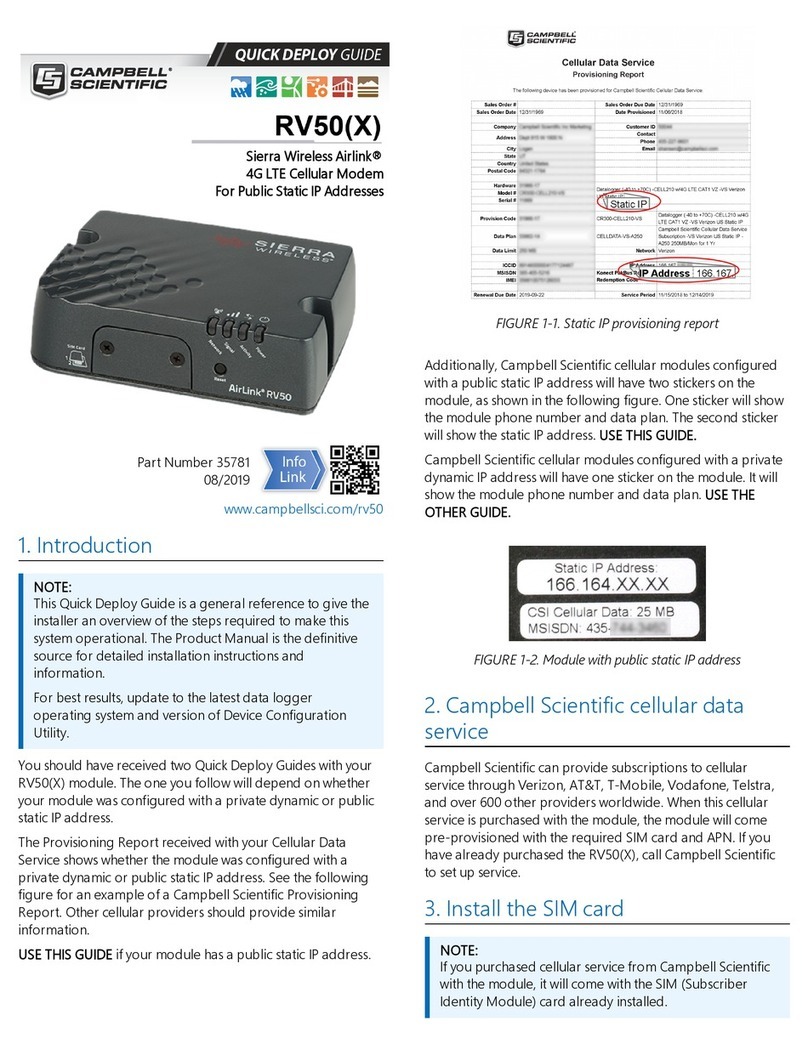
Campbell
Campbell Sierra Wireless AirLink RV50 Quick Deploy Guide
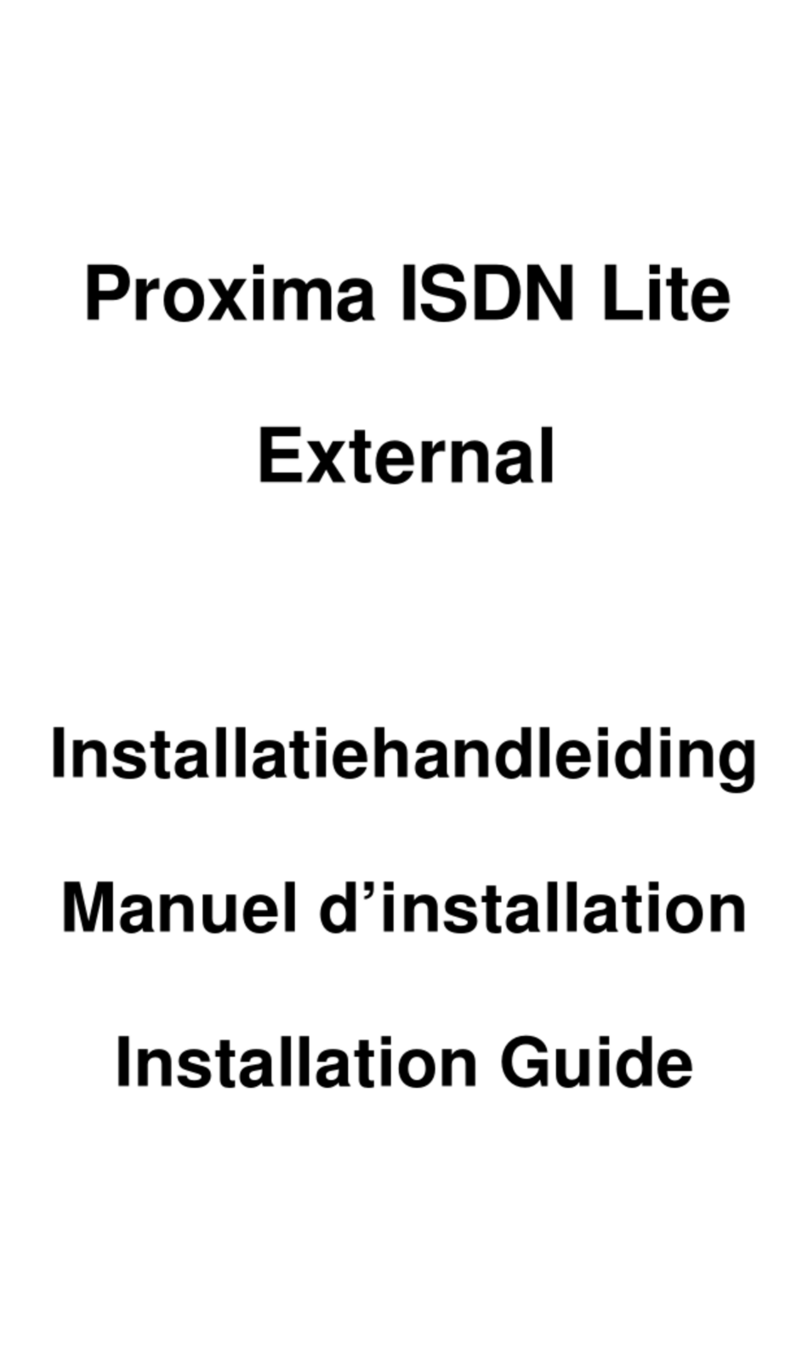
Bausch Datacom
Bausch Datacom Proxima ISDN Lite installation guide

NBN
NBN TG799 installation instructions
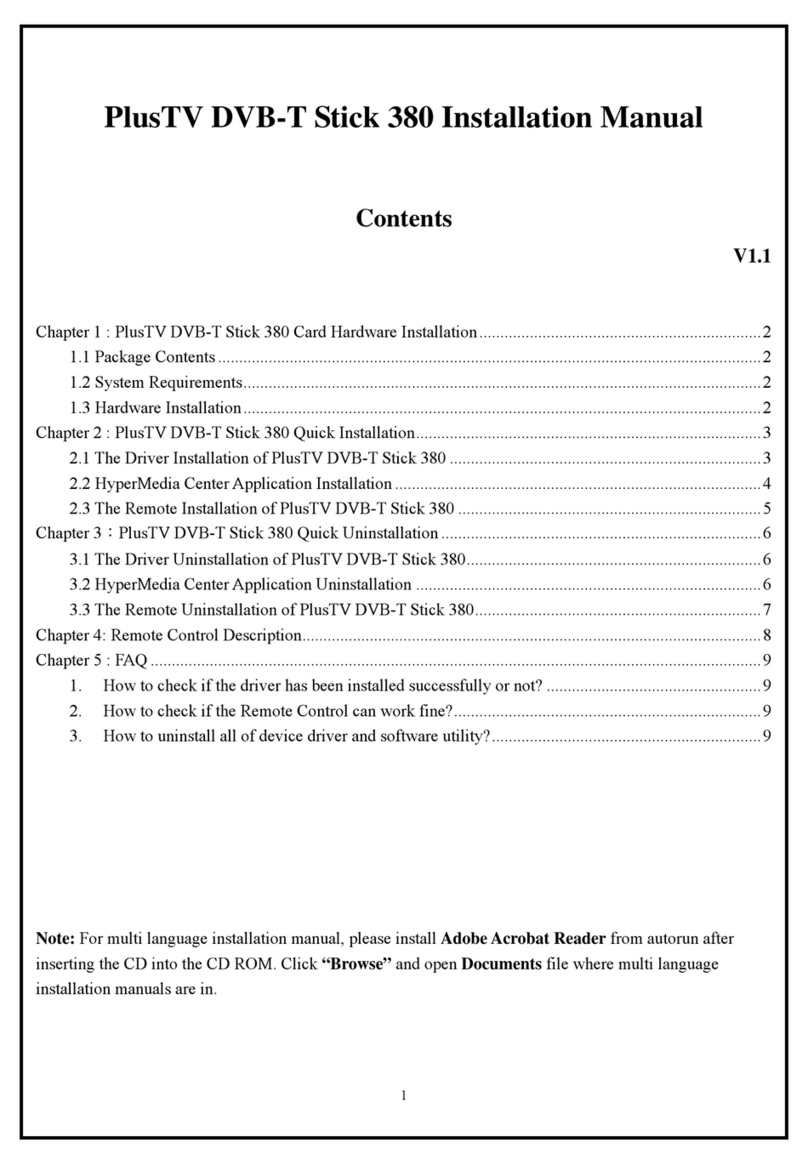
KWorld
KWorld PlusTV DVB-T 380U installation manual
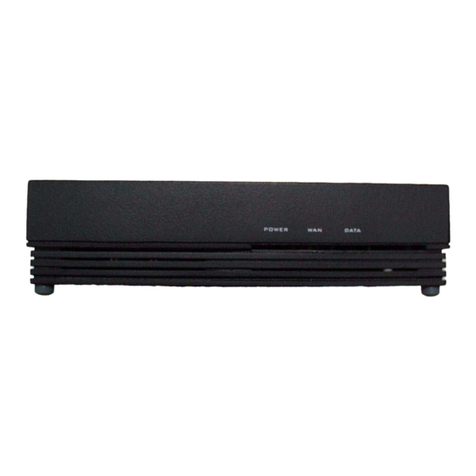
Paradyne
Paradyne Hotwire 6205 installation instructions

Zoom
Zoom 1099 Series user manual
